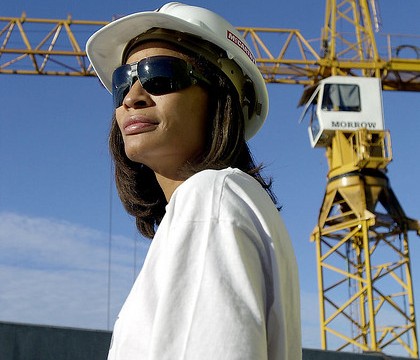Source: Legal Momentum and New York Collaboration for Women in Construction.
September 2013
In 1978, Executive Order 11246, which bans employment discrimination by government contractors on federal and federally assisted construction sites, was revised because of the “almost total exclusion of women from [construction] employment.”[i] The same year, the regulations governing registered apprenticeship programs were also revised to establish specific affirmative standards for women, who numbered between 1% and 3% of apprentices in the skilled construction trades.[ii]
Today, women hold fewer than 3% of skilled trades jobs and apprenticeships, a number lower than reported by the 1992 U.S. Government Accountability Office.[iii] In other occupations that can be as physically challenging as trades work, women’s share of employment has grown, for example, to 43% of bus drivers, 36% of paramedics, 35% of athletes/coaches/umpires, 23% of farmers and ranchers, 15% of the military, and 12% of police officers.[iv]
Approximately 3% of New York’s labor force is employed in the construction trades[v] and the need for construction jobs is increasing. In New York City alone, construction spending is expected to reach over $37 billion with government accounting for at least 35% of overall spending.[vi] In addition, New York is set to begin work on major projects in 2013, including the $500 million Kosciuzsko Bridge project, connecting Brooklyn and Queens, and the $3.9 billion Tappan Zee Bridge replacement project. “The average weekly income for the region’s construction worker – $836 – is 14 percent higher than the average for all industries combined.”[vii] Construction work offers women who are 34% more likely than men to be poor, a chance at economic security and success that is virtually unmatched.[viii] However, women represent only 1.5% of the construction industry in New York City,[ix] compared to 2% statewide,[x] less than the national average.
New York is also home to three apprenticeship programs with women at the helm. Those three programs each have 10% or more women in their programs. New York is uniquely poised to become a leader in demonstrating how to increase and sustain women’s share of employment in the construction industry. In New York City, three construction apprenticeship programs boast female apprentice percentages that range from 10 to 16%.[xi]
Best practices around the country have proven that when equal opportunity contract terms start with the pre-bidding process and are followed up with sustained on-site monitoring and enforcement, the work hours of women and people of color increase. In addition, oversight committees working to coordinate, monitor and improve equal opportunity on major construction sites have also proven successful. These oversight committees include representatives from the contracting agency, the Department of Labor, the prime and sub contractors, unions and constituency groups. For example, the oversight group for California’s General Services Administration mega-project, 50 United Nations Plaza’s renovation, produced an overall 8% women’s workforce participation on the project.
Women who enter the trades report that sex discrimination and harassment are quite common. Tradeswomen cite barriers to training and hiring, unfair job assignments and other gender discrimination as the reason women’s numbers haven’t increased. The improvement and implementation of equal opportunity policies and regulations have increased the percentages of women working in construction.[xii] To support the great strides that New York has already made in increasing the number of women apprentices and increase women’s share of the construction workforce, state policies and regulations should be reviewed, improved and implemented as needed.
The New York Collaboration for Women in Construction (CWC) is a coalition of organizations, tradeswomen, and other advocates dedicated to increasing opportunities for tradeswomen. Steering Committee members include Legal Momentum, Equal Pay Coalition NYC, Women’s City Club of New York, and leading NYC tradeswomen.
[i] 43 Fed. Reg. 14888 (April 7, 1978) (regulations); 43 Fed. Reg. 14899 (April 7, 1978) (specific hiring goals)
[ii] 43 Fed. Reg. 20769 (May 12, 1978)
[iii] Legal Momentum, “Still Excluded”(2013), available at http://www.legalmomentum.org/sites/default/files/reports/still-excluded.pdf
[iv] Women in Military Service for America Memorial Foundation, Statistics on Women in the Military (2011), available at http://www.womensmemorial.org/PDFs/StatsonWIM.pdf (military participation); U.S. Bureau of Labor Statistics, Women in the Labor Force: A Databook (2012 ed.), available at http://www.bls.gov/cps/wlf-databook-2012.pdf (non-military occupations).
[v] US Census 2010:http://factfinder2.census.gov/faces/tableservices/jsf/pages/productview.xhtml?pid=EEO_10_5YR_EEOALL2R&prodType=table
[vi] New York Building Congress, “New York Building Congress Analysis Foresees Renewed Building Boom by 2014” http://www.buildingcongress.com/outlook/062413.html
[vii] http://www.labor.ny.gov/stats/cen/construction.shtm
[viii] http://www.legalmomentum.org/resources/womens-poverty-united-states-2011
[ix] US Census 2010:http://factfinder2.census.gov/faces/tableservices/jsf/pages/productview.xhtml?pid=EEO_10_5YR_EEOALL2R&prodType=table
[x] Id.: http://factfinder2.census.gov/faces/tableservices/jsf/pages/productview.xhtml?pid=EEO_10_5YR_EEOALL2R&prodType=table
[xi] NYC District Council of Carpenters, Local 28 Sheet Metal Workers and Local 79 Laborers
[xii] Legal Momentum, WANTO’s Future (2012), available at http://www.legalmomentum.org/our-work/women-at-work/resources-and-publications/wanto-information.pdf.
September 2013


